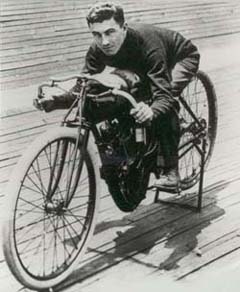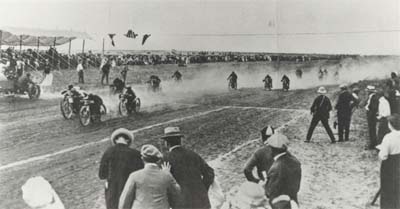by Daniel K. Statnekov |
| ©1998 - 2006 Daniel K. Statnekov |
|
Within a month of H-D's win at Venice, Indian's top management conferred
with their Engineering and Design Departments on the matter of changing
the basic design of the Hedstrom engine. Whether or not the recent
trouncing that they had suffered at the California race influenced the
Springfield company's decision to develop a new engine, the tremendous
splash of publicity in favor of their Milwaukee rival did not go unnoticed
by Indian management.
Additionally, it was an open "secret" that Schwinn's Chicago company was about to unveil its latest advancement in engine design, the "Big-Valve X," which would make its racing debut in June. Whatever the case, the Hendee Company decided, in the Spring of 1915, to begin immediate experimentation on a simplified side-valve engine that held promise for a substantial increase in power over the old Hedstrom model. While the engineers were busy at their drawing boards, the racers were battling it out on the race track. It was still a see-saw competition between the big three; each company's publicity department scrambling to make the most from whatever victory their team riders could claim in the free-for-all. Throughout the summer, Indian's Ray Creviston was the dominant flat tracker in the sport, recording wins over Excelsior's newest hope, Bob Perry, and Perry's talented teammate, Carl Goudy. Perry and Goudy were the two Excelsior riders that had finished ahead of Indian but behind the Harley-Davidson winners at the Venice road race in April. On June 19, 1915, Bob Perry and Carl Goudy put Excelsior back in the lime-light by winning the prestigious Boston 300-mile relay race on their company's new entry, the "Big-Valve X." This important race was the public debut of (what would prove to be) the ultimate evolution of Excelsior's standard motor, which now featured huge, 2 and 1/8th-inch diameter valves. With less than a month remaining before the "race of the year," it was anyone's guess as to which manufacturer's rider and machine would take the checkered flag at Dodge City to claim the landslide of publicity for their factory sponsor. Just beneath the jovial atmosphere that surrounded the buildup for the 4th of July spectacle, a serious struggle was in progress: the contest between Excelsior and Harley-Davidson for second place in industry sales. By this time, it was an accepted business fact that a major win on the race track was a key ingredient for success in the market place. Although only in its 2nd year, the 1915 Dodge City 300-miler was being hailed as the "Indianapolis" of motorcycle racing, its outcome of vital importance to the manufacturers.
Six companies fielded professional teams. The Harley-Davidson
entry consisted of eight of the Ottaway improved, standard production
racers; while Indian challenged with eight factory riders on
both standard valve as well as special 8-valve machines.
The Excelsior team, captained by Carl Goudy, rode machines powered
by the Chicago firm's newly introduced "Big-Valve" motor; while
the Minneapolis based, Joern's Mfg. company entered two of their
bright yellow, overhead-cam Cyclones that had been causing a
sensation wherever they appeared. Several Merkels, an Emblem,
and a Pope rounded out the field.
Bunched together, 29 contestants circled the 2-mile race course, positioning themselves, by pre-arrangement, in closely packed rows -- five riders abreast. The 15,000 spectators, who had gathered under a hot Kansas sun, watched as the starter, seated in an open racing car, led the riders around the track. Inez Patterson, reporting the event for "The Pacific Motorcyclist," described the spectacle as follows: |
|
When the caravan of car and riders turned onto the home stretch, the suddenly hushed crowd stood tense in the grandstand. There was a crash and roar of mechanism and exhausts. The driver of the pace car pushed his mount, already doing 50 miles per hour, and the starter waved a flag from his position in the seat. The car swerved frantically to one side of the track and 29 madmen aimed at the first turn. Women screamed, men jumped up and down and yelled. Bedlam broke loose. Dodge City was underway. A minute and twenty seconds later something red flashes by, it is Number 9 -- Taylor on an Indian -- leader in the first lap. Carl Goudy, Number 3, on his "Big Valve X" flashes by in close pursuit, and then Number 16, the yellow demon Cyclone, piloted by Don Johns. On the second round Number 16 comes first. God! such speed! Zip, Zip, Zip -- they come and go. |
|
Riding a blistering pace of 90 mph laps, Johns nearly laps the field while holding the lead until the 16th lap when he makes a pit stop for fuel. Inez Patterson continues: |
|
At just about this time there is a near riot in the grandstand. Some of the crowd thought Johns was not given credit for the right number of laps. |
|
Resuming the chase, Johns regained the lead from a pair of Excelsiors on the 24th lap. |
|
At noon, one hour after the start of the race, Perry, Stokes, Boyd, Taylor, Wolter, Weishaar, and Walker are all even. Shortly thereafter, Perry stopped in the pits with a tire torn nearly off and Patterson and Pineau were hauled into the pits. At 12:22 Floyd Clymer of Denver was towed across the field on his Excelsior. Patterson's Merkel caught fire and burned 30 yards from the grandstand. |
|
Johns continued to hold the lead until somewhere between the 70th and 80th mile, when his machine began to falter. Sometime after the 90-mile point the Cyclone suffered a broken fuel tank and Johns was forced to retire. Patterson reported: |
|
One more lap and he would have had the world's record for 100 miles. |
|
"Motorcycle Illustrated" characterized the Cyclone rider's performance as "nothing short of spectacular," and it was generally understood that Johns was pacing himself for a new 100-mile record. With Johns out, Carl Goudy took over the lead followed by Morty Graves on an 8-valve Indian in 2nd place. Otto Walker, just behind Graves, led the band of Harley's and what remained of the field. At the 100-mile mark, Goudy's Excelsior was still in the lead, and he had set a new record for the distance, aided no doubt by the extraordinary pace set earlier by the yellow demon Cyclone. The 200-mile mark was passed with Harley-Davidson's Otto Walker taking the lead, but a tire puncture forced him into the pits. This allowed Graves on the Indian-8 to take over, while Goudy slipped to 3rd place. His tire repaired, Walker was back in contention, working his way up to the front of the pack. Inez Patterson describes the end of the race: |
|
At 145 laps the officials ran across the track.
They posted one man way toward the turn so
he could signal the flagman when the winner
came up. The Indian crowd was jumping up and
down for Graves was nearly a lap to the good.
The Harley-Davidson crowd stood solemn, for
dogged as he was it looked bad for Walker. |
 Morty Graves
|
Both Morty Graves and Otto Walker were born in 1890. Unlike the
Harley-Davidson team captain, who began to race in 1911, Graves
started his career in 1906 when he was 16 years-old. This was the
so-called Pioneer era, when motorcycles used wooden rims and
bicycle spokes, before a mile-a-minute had become a reality.
In 1907, on an example of Indian's first catalogued racer, Morty bested
his competition at the old Ascot Track in Los Angeles, posting a 65 mph
average to claim his first significant victory. In 1909, as the board track era
was being born, Morty Graves became a member of the first cadre of
motorcycle riders to compete in the new death-defying sport. More often
than not Morty was either a top contender or the victor in race after race on
the national circuit. |
|
The next to the last lap flag had been given and eyes began straining for Graves. There he stood on the backstretch -- out of gas. That was one time when an ink bottle full of gas would have been worth $800.00 to Morty. Walker barged on around and then the brown-coated Harley-Davidson crew began jumping and the Indian men stood solemn. In the pits Don Johns pointed silently to a big rent in the top of his tank. He had just ridden the rest of the machine from around the engine. |
|
Losing Dodge City in the last lap of the July, 1915 race was discouraging for Morty Graves. The Indian team rider had been thinking of retirement so when the bottom dropped out of his gas tank in the last mile of yet another 300-miler in September (Morty had a 7-mile lead at the time), the 25 year-old seasoned veteran called it a day and took with him into retirement the memory of an illustrious career, a list of world records and victories, and an enduring fellowship with the unique fraternity of men of which he was a founding member. Although Excelsior's Carl Goudy placed 3rd at the Dodge City extravaganza, Ottaway's Harley-Davidsons took 6 out of the 7 top spots. It was dramatic and important. In less than two years, the Milwaukee company had gone from the manufacturer of a plodding, dependable motorcycle, to the sponsor of a professional team, capable of winning the most prestigious race in America. The publicity resulting from their success was such that nearly all of H-D's dealers reported increased sales, and the factory raised its production target for the following season. |
|
|
|
|
|
Webmaster: daniels@statnekov.com |
Page installed: Nov. 15, 1996 Page revised: June 28, 2003 |
